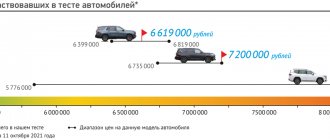How and when the VSM system is activated
This system is used as an add-on over other traffic stabilization aids, and automakers usually define it in their descriptions as an addition to their list. Existing indicators can be used to signal activation, for example, ESC and EPS activation in Hyundai Accent or Creta.
Active Steering mode is switched off when driving in reverse or on a slope. Speed limits for inclusion are speeds above 15 km/h on a road with turns and above 20 km/h when braking. You can disable or enable this mode manually by pressing the ESC OFF button. The activation of the equipment is felt by ear and by a slight pulsating movement of the brake pedal.
VSC System: what is it on Toyota and Lexus
Tire tread wear, weather conditions, and incorrect driver actions are the reasons why a car can skid.
The wheels lose traction with the roadway, and the rear part of the car is pulled by the lateral force to the right or left of the motion vector. Sudden movements of the steering wheel, emergency braking or disengagement of the clutch aggravate the situation: the car begins to spin, and when colliding with an obstacle (curb, snowdrift) or driving into a ditch, the car may tip over. To avoid such a situation, engineers at the Japanese automaker Toyota have developed an electronic system that reads the readings of several sensors and helps the driver prevent the car from skidding. The system was called VSC System.
Troubleshooting
Type 9 error codes common to all Toyota vehicles are represented by two-digit codes.
| Code | Decoding |
| 11 | No power to EFI unit |
| 12 | No signal from the engine speed sensor |
| 13 | No signal from the engine speed sensor at speeds above 1000 rpm |
| 14 | There is no signal from the minus ignition coil or from the minus coil number one (if there are two of them) |
| 15 | There is no signal from the minus of ignition coil number two |
| 16 | There is no connection between the automatic transmission control unit and the engine control unit |
| 17 | Incorrect signal from camshaft position sensor number 1 |
| 18 | Incorrect signal from camshaft position sensor number 2 |
| 21 | Incorrect signal from the oxygen sensor, if the engine is V-shaped, then the heater of the left main oxygen sensor is faulty |
| 22 | Incorrect signal from engine temperature sensor (THW) |
| 23 | Incorrect signal from the intake air temperature (THA) sensor |
| 24 | Incorrect signal from the intake air temperature (THA) sensor |
| 25 | Mixture too lean |
| 26 | Mixture too rich |
| 27 | Incorrect signal from the additional oxygen sensor (left for V-engines) |
| 28 | Incorrect signal from the oxygen sensor (on V-engines, the heater of the right main oxygen sensor) |
| 29 | The additional oxygen sensor is faulty (right for V-engines) |
| 31 | Incorrect signal from the air flow sensor or, if there is none, from the pressure sensor in the intake manifold (vacuum sensor) |
| 32 | Incorrect signal from air flow sensor |
| 34 | Boost faulty |
| 35 | Incorrect signal from the atmospheric pressure sensor in the intake manifold (vacuum sensor) |
| 38 | Automatic transmission fluid temperature sensor |
| 41 | Incorrect signal from throttle position sensor (TPS) |
| 42 | Incorrect signal from the vehicle speed sensor (speedometer) |
| 43 | No starter signal (STA) to engine control unit |
| 46 | Solenoid valve number 4 or its circuits are faulty |
| 47 | The auxiliary throttle position sensor (TPS) or its circuit is faulty |
| 48 | The auxiliary air supply control system is faulty |
| 51 | No idle signal from TPS |
| 52 | Incorrect signal from the knock sensor (if there are two of them, then from the left or from the front) |
| 53 | Problems in knock sensor control circuits (ignition timing) |
| 55 | Incorrect signal from the knock sensor (if there are two of them, then from the right or from the rear) |
| 61 | The main speed sensor or its circuit is faulty |
| 62 | Solenoid valve number 1 or its circuits are faulty |
| 63 | Solenoid valve number 2 or its circuits are faulty |
| 64 | Solenoid valve number 3 or its circuits are faulty |
| 65 | Solenoid valve number 4 or its circuits are faulty |
| 67 | The O/D switch or its circuit is faulty |
| 71 | EGR control system faulty |
| 72 | Fuel cut solenoid |
| 77 | The pressure control solenoid or its circuit is faulty (in the machine) |
| 78 | There is no signal to the fuel pump or its circuits are faulty |
| 81 | The circuit between TCM and ECT1 is faulty |
| 82 | The circuit between TCM and ESA1 is faulty |
| 84 | The circuit between TCM and ESA2 is faulty |
| 85 | The circuit between TCM and ESA3 is faulty |
| 86 | Engine speed sensor is faulty |
| 88 | The circuit from the engine control unit to the automatic transmission control unit is faulty |
| 89 | Communication between the engine control unit and the TRC system control unit is broken |
| 99 | No fault codes |
The general list of unambiguous codes (type 10) for a Toyota car consists of the following items.
| Code | Decoding |
| 1 | No breakdowns |
| 2 | The air flow sensor gives an incorrect signal |
| 3 | Incorrect signal from the communicator |
| 4 | The coolant temperature is outside the normal range, the sensor has failed |
| 5 | Incorrect communication with the oxygen sensor |
| 6 | The fault lies in the number of engine revolutions |
| 7 | Throttle valve in incorrect position |
| 8 | The sensor shows incorrect intake air temperature |
| 9 | Car speed problem |
| 10 | There is no starter signal |
| 11 | The air conditioner is broken or the toggle switch responsible for the neutral position in the car is faulty |
Gasoline internal combustion engines
If the car has an on-board computer or robot, the code will appear on the mileage screen. It will consist of a Latin letter at the beginning, for example P, B, C, and 4 numbers. This is typical for cars such as Toyota Rav 4 Avensis, Corolla, Mark II or Land Cruiser 200, Toyota Prado 120 and others that run on gasoline.
Table for deciphering diagnostic fault codes for gasoline internal combustion engines.
| Codes | Decoding | Analogue on BC |
| 12 and 13 | Problems with the crankshaft position sensor | P0335, P0335, P1335 |
| 14 and 15 | Problems with the ignition system or coils | P1300 and P1315, P1305 and P1310 |
| 18 | VVT-i phase system | P1346 |
| 19 | Accelerator pedal position | P1120 and P1121 |
| 21 | Oxygen sensor | P0135 |
| 22 | Coolant temperature | P0115 |
| 24 | Damage to the intake air temperature sensor | P0110 |
| 25 | Oxygen sensor - lean mixture | P0171 |
| 31 | Absolute pressure sensor | P0105 and P0106 |
| 36 | CPS sensor | P1105 |
| 39 | VVT-i system | P1656 |
| 41 | Throttle position | P0120, P0121 |
| 42 | Vehicle speed sensor problems | P0500 |
| 49 | Fuel pressure D-4 | P0190, P0191 |
| 52 and 55 | Knock sensor failure | P0325 |
| 58 | SCV drive | P1415, P1416, P1653 |
| 59 | Incorrect VVT-i signal | P1349 |
| 71 | EGR system | P0401, P0403 |
| 89 | ETCS drive | P1125, P1126, P1127, P1128, P1129, P1633 |
| 92 | Cold start injector problems | P1210 |
| 97 | Injector faulty | P1215 |
Diesel engines
Many Toyota cars were produced with a diesel engine. The most popular models are the Vitz, Caldina, Avensis (T25), Camry, Camry Grazia, Corolla E150, Auris 2008 sedans, Land Cruiser Prado 120 and Land Cruiser Prado 200 SUVs or the RAV4 crossover.
When writing down codes for diesel cars, you can see the following symbols.
| Code | Decoding |
| 13 | Rotation speed is outside the permissible limits |
| 19 | Incorrect accelerator pedal position |
| 22 | Malfunction in coolant temperature indicators |
| 24 | Incorrect intake air temperature data |
| 35 | Boost pressure is out of range |
| 39 | Fuel temperature sensors do not work well |
| 42 | The fault lies in the vehicle speed sensor |
| 96 | EGR valve position is incorrect |
Failure of other diesel engine parts.
| Code | Decoding |
| 12 | Crankshaft position problem |
| 14 | Damage to the valve that regulates the injection advance angle |
| 15 | The throttle servo is faulty |
| 17 | Incorrect signal coming from the control unit |
| 18 | Damage to the solenoid bypass valve |
| 32 | Failure of correction resistors |
Automatic transmission
Cars of the same brand differ not only in the engine, but also in the gearbox. For the same Toyota Corolla 150, Celsior or Vista, automatic transmission failures will differ from mechanical failures.
If there is a malfunction in the transmission, you will see one of the codes.
| Code | Decoding | Analogue for automatic transmission |
| 37 | Transmission input shaft speed sensor malfunction | P1705 |
| 42, 44, 36 | The problem is in the speed sensor (maybe shaft speed) | P0500 |
| 46 | Accumulator pressure, solenoid faulty | P1765 |
| 62, 63 | Problems with one of the solenoids | P0753 P0758 |
| 64, 68 | Torque converter lock-up clutch, solenoid faulty | P0773 |
Such errors are typical for different models, including Toyota Ipsum, Toyota Highlander 2001 and Caldina.
Other combinations
Special equipment and devices are also used for diagnostics. Such devices will show five-digit codes. They can also be recognized using the on-board computer, which is installed in new cars and hybrid models.
Code on the Toyota screen with on-board computer
Toyota Estima, Toyota Prius, third generation Toyota Harrier and others came out in the hybrid version. These models (in addition to other breakdowns) may experience malfunctions of the high-voltage battery system (HVB). Hybrid installation error codes and their interpretations are given in the table.
The most common non-VVB error codes are:
| Code | Decoding |
| P1604 | Engine starting failed, failure in the intake system |
| B0101 | The security system does not work correctly, there are problems with the airbags |
| In 1801 | The squib circuits on the driver's side are broken. |
| C1201 | Engine operation is incorrect, speed is below the permissible level |
| P0420 | Catalyst system B1 operates below the permissible efficiency threshold |
| P0352З | Problems in the ignition system circuits |
The photo gallery shows errors in the operation of the immobilizer and tires on Toyota cars.
Troubleshooting
To troubleshoot problems, you need to visit a technical service center or an authorized dealer. There they will conduct a check and computer diagnostics. Reading the error code will help determine the cause of the malfunction.
Frequent reasons for the VSC TRC off CHECK indicator lights to operate in the Prado 120:
Don't ignore warning lights in your car. Contact the service in a timely manner to troubleshoot problems.
Source
see also
Comments 26
Is the problem resolved? Now I have the same combination that lights up, but it doesn’t light up all the time, and a couple of times the trc Activ light came on on the dashboard and the pads grabbed the wheels, and on smooth, dry asphalt. While I’m driving like this.
No, I haven’t decided, I’ve been going somewhere for a month now,
And I thought it was no longer fashionable to drive like this
Oooh PROVET )))) The same crap))) but my front left ABS sensor has died, since October somewhere)) I’m driving and somehow I like it better, I started to feel the car better, much better, I’m not talking about the dimensions, but about what’s in her Soul, it’s much more powerful than with these sensors, and after riding for so long to put it on, I even think now, I understand it’s necessary, safety and the rest, but it’s as if he breathed into all his lungs. Exactly in its entire volume... but without a pillow)))) only three light bulbs)
The VSC light came on in the car
One of the reasons why the VSC check engine lights come on is due to a faulty steering loop, but if everything is fine with it, you should take care of calibrating the directional stability sensor. And since there is an opinion among many that such a procedure cannot be performed, we will try to dispel this myth and understand the sequence of eliminating the problem.
However, it is worth noting that some owners do not want to do this, simply replacing the sensor with a new one. However, the cost of the sensor is steep, and therefore it would be useful to know how you can really save money.
Certain Toyota models equipped with the VSC (ESP) system indicate by the corresponding lights that problems have arisen, indicated by the following fault codes:
• C1336 (39) — Calibration work to zero the deceleration control sensor was not performed;
Payment via Yandex Cashier
After selecting payment via Yandex, the Yandex Cashier payment system will launch, where you need to select a convenient payment method (bank card, QIWI, Yandex Money account, etc.)
After specifying payment details and confirming payment, payment for the goods will occur.
If you have a bank card in a currency other than the ruble, then the money will be debited from the card at the rate of the Central Bank of Russia at the time of the purchase.
This payment method is optimal for residents of Russia, Kazakhstan and Belarus.
ESP - Electronic Stability Program ESP control de estabilidad electronic stability control what is ESP?










